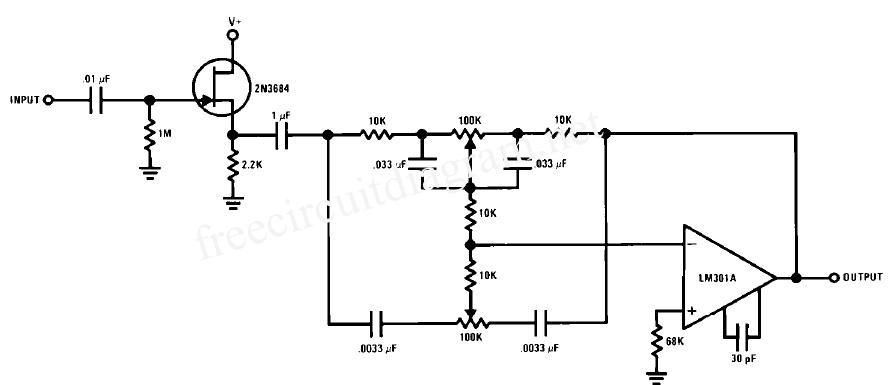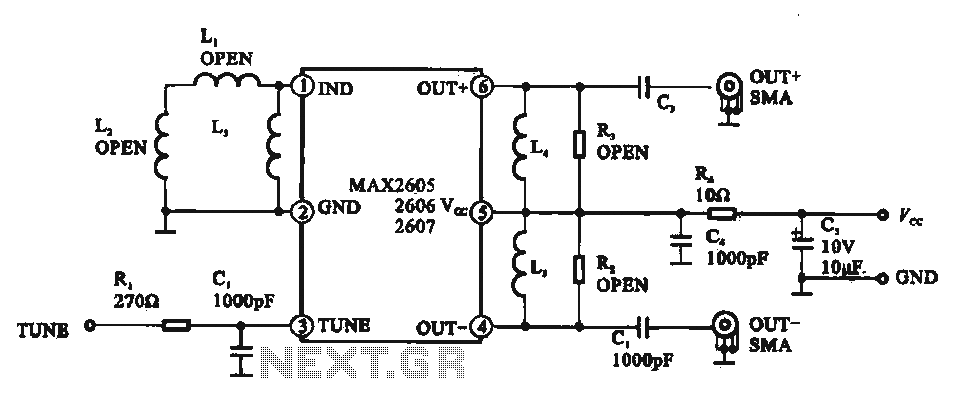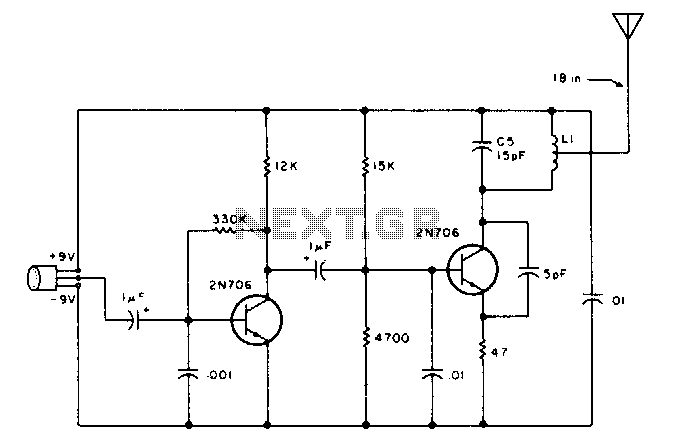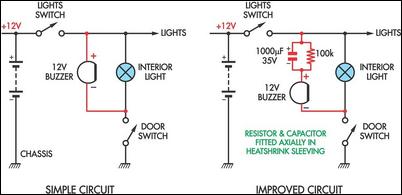
HI-FI simple Tone Control Circuit using the LM301A

This circuit is a simple series tone control circuit utilizing the OP-Amp LM301A. The JFET 2N3684 provides high input impedance and low noise characteristics for the feedback buffer in the op-amp-based tone control.
The tone control circuit described employs an operational amplifier (Op-Amp) LM301A, which is a versatile component known for its wide bandwidth and low distortion, making it suitable for audio applications. The circuit's primary function is to adjust the tonal quality of audio signals by altering the frequency response, allowing for enhancements in bass, midrange, and treble frequencies.
The inclusion of the JFET 2N3684 is critical for maintaining a high input impedance, which is essential for preventing signal loss and ensuring that the circuit can interface effectively with various audio sources without loading them down. The low noise characteristics of the 2N3684 contribute to a cleaner signal path, minimizing unwanted noise and distortion that can degrade audio quality.
In a typical configuration, the LM301A is set up in a feedback arrangement, where the input audio signal is fed into the inverting or non-inverting terminal, depending on the desired phase. Capacitors and resistors are strategically placed within the circuit to create a frequency-selective network, allowing the user to boost or cut specific frequency bands. The output of the Op-Amp then delivers the modified audio signal to the next stage in the audio processing chain.
Overall, this tone control circuit is an effective solution for audio applications requiring customizable frequency response, leveraging the strengths of both the LM301A Op-Amp and the JFET 2N3684 to achieve high-performance audio processing.This circuit is a simple series of tone control circuit. This tone control circuits using OP-Amp LM301A. The JFET 2N3684 provides high input impedance function and low noise characteristics for a feedback buffer op-amps operated type tone control. 🔗 External reference
The tone control circuit described employs an operational amplifier (Op-Amp) LM301A, which is a versatile component known for its wide bandwidth and low distortion, making it suitable for audio applications. The circuit's primary function is to adjust the tonal quality of audio signals by altering the frequency response, allowing for enhancements in bass, midrange, and treble frequencies.
The inclusion of the JFET 2N3684 is critical for maintaining a high input impedance, which is essential for preventing signal loss and ensuring that the circuit can interface effectively with various audio sources without loading them down. The low noise characteristics of the 2N3684 contribute to a cleaner signal path, minimizing unwanted noise and distortion that can degrade audio quality.
In a typical configuration, the LM301A is set up in a feedback arrangement, where the input audio signal is fed into the inverting or non-inverting terminal, depending on the desired phase. Capacitors and resistors are strategically placed within the circuit to create a frequency-selective network, allowing the user to boost or cut specific frequency bands. The output of the Op-Amp then delivers the modified audio signal to the next stage in the audio processing chain.
Overall, this tone control circuit is an effective solution for audio applications requiring customizable frequency response, leveraging the strengths of both the LM301A Op-Amp and the JFET 2N3684 to achieve high-performance audio processing.This circuit is a simple series of tone control circuit. This tone control circuits using OP-Amp LM301A. The JFET 2N3684 provides high input impedance function and low noise characteristics for a feedback buffer op-amps operated type tone control. 🔗 External reference





